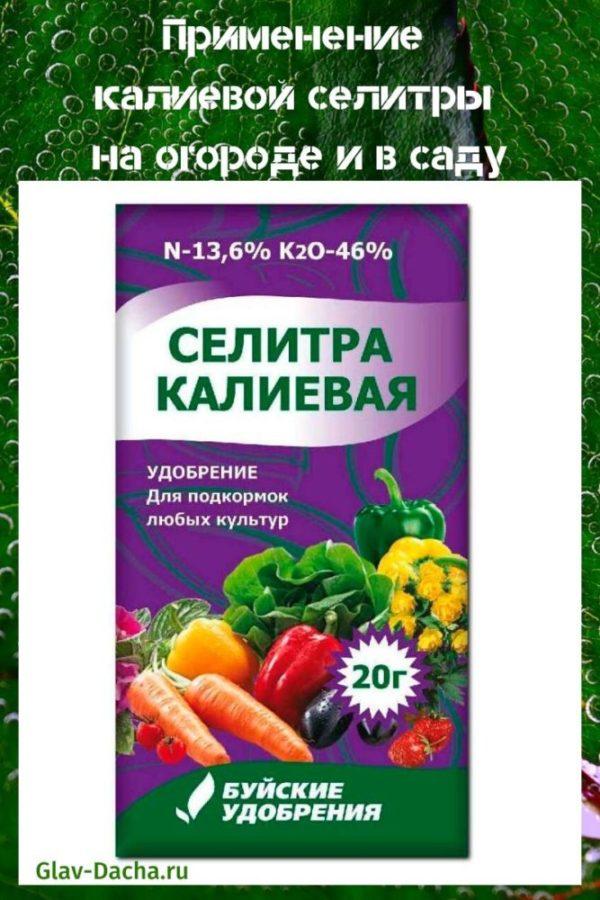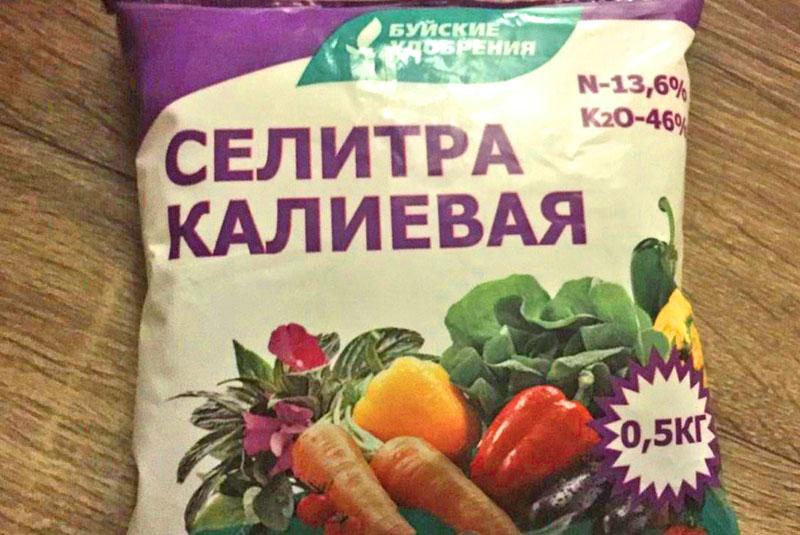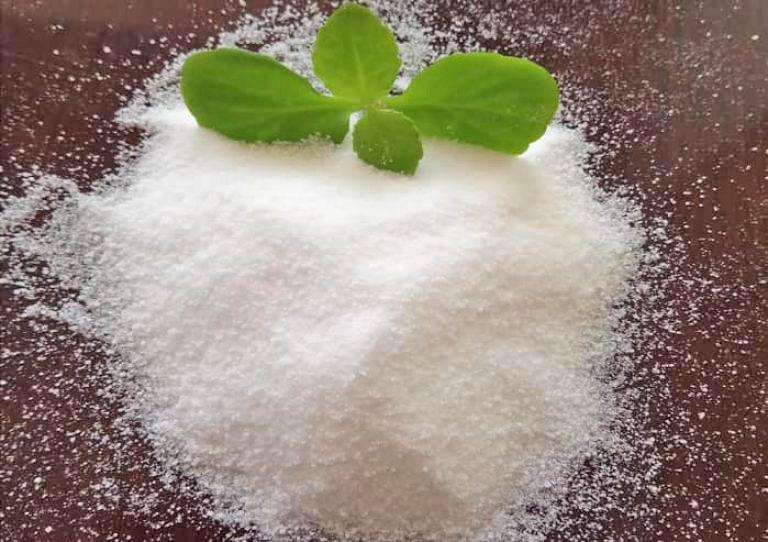The use of potassium nitrate in the garden and in the garden
 For the successful cultivation of any crop, regular feeding is necessary, which will provide it with a full set of useful elements for full growth and development. Potassium nitrate will help not only strengthen the plant's immune system, improve the condition of the soil, but also get rich harvests every year. The use of potassium nitrate requires precise dosage, adherence to the timing and application methods, taking into account the season and type of crop grown.
For the successful cultivation of any crop, regular feeding is necessary, which will provide it with a full set of useful elements for full growth and development. Potassium nitrate will help not only strengthen the plant's immune system, improve the condition of the soil, but also get rich harvests every year. The use of potassium nitrate requires precise dosage, adherence to the timing and application methods, taking into account the season and type of crop grown.
The composition and purpose of potassium nitrate

The chemical formula of potassium nitrate is KNO3. The tool is a crystalline substance without a pronounced odor, white. In powder form, it can have a gray or yellow tint. The drug is not toxic to living organisms.
Potassium nitrate contains 45% potassium, 13% nitrogen. These substances are included in the list of basic plant nutrients. Plants require nitrogen for active growth of green mass, potassium for abundant flowering and fruiting.
With the correct use of complex fertilizer, the following results can be achieved:
- Agricultural crops in the shortest possible time overcome the initial stages of development, and quickly move from a weak sprout to an adult, strong plant that is not afraid of sudden temperature changes and other negative factors of influence on it.
- Fertilizers are also effective for crops growing on nitrogen-poor soils.
- The efficiency of the root system increases. It intensively begins to absorb the required substances from the soil.
- Cellular respiration improves due to biochemical reactions in which the agent plays the role of a catalyst.
Knowing what potassium nitrate is needed for plants, you can get a crop with excellent taste, as well as flower bedsthat will decorate the most unsightly corners of the garden.
Advantages and disadvantages of valuable fertilizer

Potassium nitrate has a number of advantages, which allows it to maintain its place among the popular complex fertilizers, since:
- increases the resistance of crops to adverse environmental conditions;
- strengthens the immunity of plants, enhances resistance to fungal infections;
- contributes to the increase in overall yield indicators;
- improves the taste characteristics of fruits, their appearance;
- increases the storage period of the crop;
- dissolves completely in water in 4-5 minutes, which makes it easier to apply fertilizer by spraying;
- has a low level of toxicity;
- shows efficiency with minerals and pesticides, subject to the norms and feeding regime;
- refers to environmentally friendly fertilizers, does not contain impurities;
- is a safe preparation for all garden, ornamental, garden plants, as the composition does not contain chlorine, salts of heavy metals;
The disadvantages include the effect of potassium nitrate on soil properties (salinity, acidity). Before using potassium nitrate, conduct tests for compatibility and appropriateness of use. Cannot be mixed with organic matter, ammonium sulfate, potassium carbonate.
How to make potassium nitrate at home
 The product can be purchased dry at any hardware store.To use it as a fertilizer, it is enough to dilute the powder with water in the proportions indicated in the instructions for use of potassium nitrate.
The product can be purchased dry at any hardware store.To use it as a fertilizer, it is enough to dilute the powder with water in the proportions indicated in the instructions for use of potassium nitrate.
You can also make a complex nutritional composition yourself.
Components and their proportions:
- 100 g of potassium chloride;
- 95 g of ammonium nitrate;
- 350 g of distilled water.
A step-by-step guide to making a fertilizer:
- Send potassium chloride to a glass bottle, pour hot distilled water. Shake the container well until the substance is completely dissolved.
- Filter the resulting solution through a gauze cloth. As a result, the liquid should be transparent and have a pink tint.
- Pour the solution into a pan of enamel and heat until boiling, then add ammonium nitrate in small portions, not forgetting to stir the composition.
- Boil the solution for 3 minutes.
- When the solution becomes clear, it should be removed from the heat and wait until the liquid stops steaming.
- Pour the solution into a container, preferably a plastic one, and put it in a cool room until it is completely cooled.
- After 2-3 hours, put in the refrigerator for 1 hour, and then move to the freezer for 3 hours.
- Remove the solution from the cold and carefully drain the water. Crystals of potassium nitrate will remain at the bottom, they must be laid out on paper and left to dry for 3-4 days in a room with a warm temperature.
When all the steps are followed strictly according to the instructions, the output will be up to 60 g of dry matter.
In the process of preparing potassium nitrate, all manipulations should be carried out in a room with good air circulation.
The use of potassium nitrate
Potassium nitrate is used as a solution for root and foliar dressing.
Root dressing
 This is a method of applying potassium nitrate, in which the assimilation of nutrients occurs by their absorption by the root system of the plant. This agrotechnical technique allows you to quickly fill the deficiency of nutrients in the soil.
This is a method of applying potassium nitrate, in which the assimilation of nutrients occurs by their absorption by the root system of the plant. This agrotechnical technique allows you to quickly fill the deficiency of nutrients in the soil.
Potassium nitrate can be added both dry and liquid:
- When using liquid potassium nitrate, the remedy will start to work faster. The working solution is used for feeding fruit and berry crops, decorative flowers, plants.
- For root crops, it is better to apply the dry method of fertilizing - before planting when digging soil in the garden.
After root feeding, water the plants abundantly to avoid root burns.
The nature and specificity of root dressing depends on each specific crop. Some plants need regular feeding, others - no more than 3 procedures for the whole season.
| Culture | Consumption for 10 liters of water | Periodicity |
| Vegetables, flowers | 15-20 g | 1 time in 10-15 days |
| Berry bushes | 20-25 g | |
| Fruit trees | 25-30 g |
The use of potassium nitrate for flowers performs the same function as for the fertilization of vegetable crops. The tool is able to strengthen the roots of flowering plants, eliminate harmful insects from the soil substrate. For feeding, it is recommended to add dry saltpeter crystals to the soil.
Foliar dressing
 Foliar dressing is recommended as an operative way to eliminate the symptoms of nutrient deficiency. This method involves applying a concentrated solution over the sheet by spraying.
Foliar dressing is recommended as an operative way to eliminate the symptoms of nutrient deficiency. This method involves applying a concentrated solution over the sheet by spraying.
It is possible to add the nutrient composition for the green mass in the morning or in the evening, it is possible during the day in cloudy weather, since it is important to ensure slow absorption of the working solution. It is impossible to do this in the bright sun, the liquid from the foliage will evaporate without suction. In addition, burns will appear on the leaves.
When processing plants, it is necessary to moisten the entire leaf plate with a solution from above and below.
Each crop has its own characteristics of growing and harvesting. Therefore, potassium nitrate is required to be applied at different periods of development and in different doses and rates.
| Culture | Consumption for 10 liters of water | Periodicity |
| Vegetables, flowers | 15-20 g; 1-1.5 l per 10 m2 | 2-4 sprays throughout the growing season |
| Berry bushes | 20-25 g; 1.5 l per 1 bush | |
| Fruit trees | 25-30 g; 2 l for young seedlings, 5-8 l for mature trees |
Failure to comply with dosages, timing of application, uniformity of distribution of potassium nitrate can destroy even healthy and strong plants.
When is the use of potassium nitrate necessary
 Fertilizer should be applied at different periods of plant growth.
Fertilizer should be applied at different periods of plant growth.
Stages of adding potassium nitrate:
- In the middle of spring.
- When landing or 1-2 days before.
- During bud formation.
- In the fall after harvest in preparation for winter
Also, this procedure is recommended in the summer - if you have the following symptoms:
- retardation of growth and development of culture;
- dry leaf tips;
- wilting of the ovaries, which gradually begin to fall off.
Potassium nitrate should not be abused, because of an excess of fertilizer, nitrates accumulate in the fruits, which can negatively affect human health.
Mandatory safety measures when using fertilizer
 When working with the drug, you need to use personal protective equipment for the skin, eyes and respiratory tract, using special glasses, a respirator, gloves. Wear tight clothing to reduce the risk of vapors getting on your skin. Before starting the event, make sure that there are no children or pets nearby. It is important not to forget that the drug belongs to the third hazard class.
When working with the drug, you need to use personal protective equipment for the skin, eyes and respiratory tract, using special glasses, a respirator, gloves. Wear tight clothing to reduce the risk of vapors getting on your skin. Before starting the event, make sure that there are no children or pets nearby. It is important not to forget that the drug belongs to the third hazard class.
When preparing a solution, it is forbidden to take dishes intended for food. In the process of work, you must not smoke, use water, food.
After the procedure, wash your hands with detergents and rinse your mouth. Rinse the container where the composition was and keep it separate from the rest of the dishes, not using for other purposes.
Proper storage conditions

When storing potassium nitrate, certain points must be taken into account:
- The packaging must be hermetically sealed and secure.
- Keep the product in a dry place, nitrate absorbs moisture, which can cause the fertilizer to cake.
- Potassium nitrate is an explosive agent, therefore, keep away from heating devices, as well as in the vicinity of flammable substances, alkaline compounds.
- It is unacceptable for the preparation to be exposed to direct sunlight and exposure to hot air currents.
- Store the product in a place protected from children and pets.
The working solution is not subject to long-term storage; potassium nitrate must be diluted immediately before use.
Potassium nitrate is an effective complex fertilizer that will revive vegetable plantings and ornamental plantings. It is important when using the product to strictly adhere to the dosages recommended by the manufacturer and observe safety precautions.